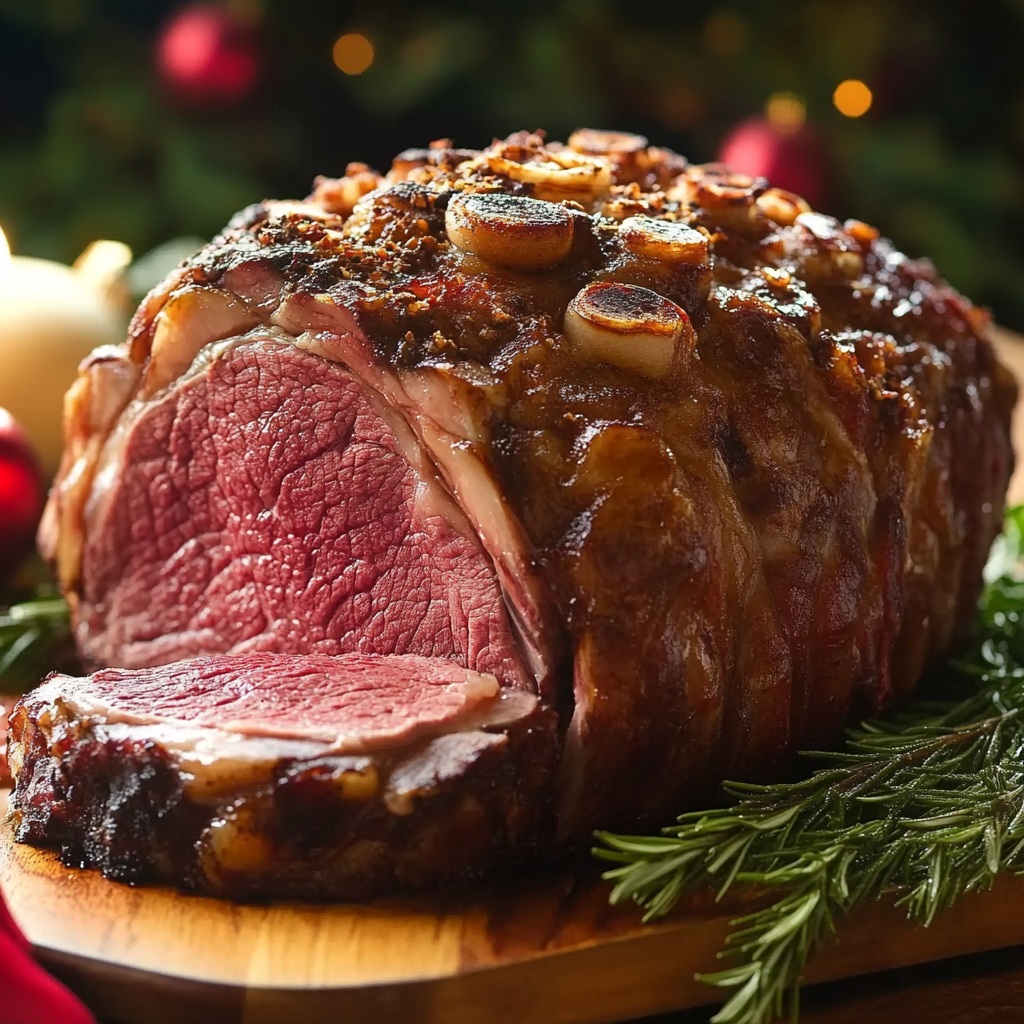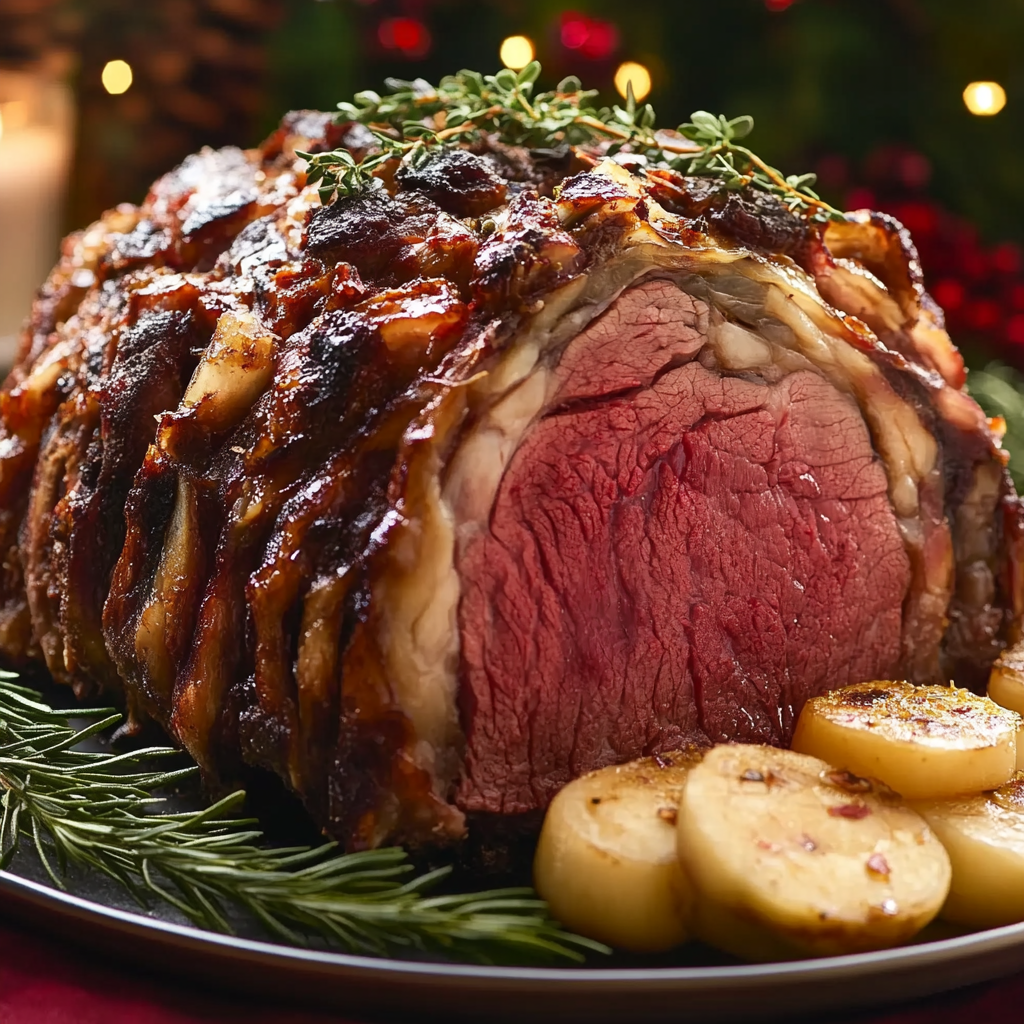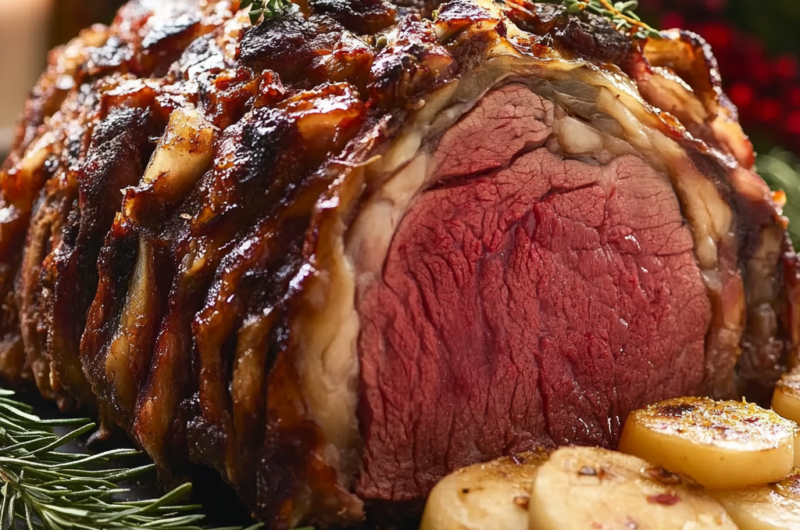Festive Holiday Prime Rib
Prime rib is often the star of any holiday dinner, and for good reason. Its rich, tender meat and golden, crispy crust make it the perfect choice for special occasions, from Christmas dinners to New Year’s feasts. Whether you’re cooking a bone in prime rib roast recipe for a crowd or preparing a smaller cut, this festive holiday prime rib will impress your guests with its flavor and presentation. The key to achieving that perfect roast lies in understanding the nuances of cooking prime rib, from choosing the right cut to knowing the ideal medium prime rib temp for optimal doneness. In this guide, you’ll learn how to master how long to cook prime rib in oven, tips for a juicy roast, and answers to common questions like, how do I cook a small prime rib roast? With our step-by-step instructions, your holiday meal will be a delicious success that everyone will remember.

Table of Contents
Why You’ll Love This Dish
Prime rib is more than just a meal; it’s an experience. The rich marbling of fat throughout the meat ensures every bite is flavorful and tender, making it the ultimate indulgence for any holiday gathering. One of the reasons this dish is so beloved is because it’s easy to customize to suit your guests’ preferences, whether you like your roast rare, medium, or well-done. A bone in prime rib roast recipe is often preferred for its robust flavor, with the bones helping to retain moisture and enhance the meat’s taste. The cooking process allows the fat to render, producing a luscious, golden crust that perfectly complements the juicy interior. Not only is it a show-stopping centerpiece, but the leftovers can be used for sandwiches, salads, or soups. With proper guidance, cooking prime rib can be surprisingly straightforward, making it an ideal choice for both seasoned cooks and beginners.
History Behind the Recipe
Prime rib has a long-standing tradition in American and European cuisine, often associated with festive occasions and elaborate dinners. The term “prime rib” refers to the quality of the meat (with “prime” signifying top-tier beef) and the cut, which is from the primal rib section of the cow. Though it has been enjoyed for centuries, it became especially popular in the United States in the mid-20th century. Traditionally, bone in prime rib roast recipes were reserved for special events, given the size and price of the cut. Over time, its association with holidays like Christmas and New Year’s Day solidified its place in American culinary culture. Cooking prime rib became an art in itself, with many chefs perfecting techniques like the high-temperature sear followed by slow roasting to preserve juiciness and achieve that coveted crispy crust. Today, cooking prime rib is a tradition passed down through generations, a symbol of celebration, and an iconic dish served in homes around the world.
Common Mistakes to Avoid
Cooking prime rib can be a bit intimidating, especially for those who haven’t prepared it before. One of the most common mistakes is overcooking the roast. Remember, how long to cook prime rib in oven depends on the size of the roast and the desired level of doneness. Many cooks make the error of using the same cooking time for every roast, but each cut is different. For example, a 5-pound roast will cook faster than a 10-pound one. Another mistake is not letting the meat rest after cooking. It’s tempting to carve right away, but allowing the prime rib to rest for 15-20 minutes will help redistribute the juices, resulting in a juicier roast. Additionally, be mindful of the temperature you’re cooking to. Medium prime rib temp is around 135°F, and cooking beyond that will lead to dryness. Lastly, make sure you’re using a meat thermometer to check the roast’s internal temperature—this is the best way to avoid guesswork and ensure a perfectly cooked prime rib.
Tips to Enhance the Dish
To elevate your festive holiday prime rib, there are a few key tips to keep in mind. First, seasoning is crucial. Generously season the roast with salt, pepper, and any additional herbs you like (rosemary, thyme, and garlic are classic choices). Let the prime rib sit at room temperature for at least an hour before cooking to ensure even heat distribution. For extra flavor, create a herb crust by mixing minced garlic, rosemary, thyme, and olive oil, then rub it onto the roast before cooking. Another helpful tip is to start cooking the roast at a high temperature (around 450°F) for 15-20 minutes to develop a crust, then reduce the heat to 325°F to finish cooking. This will ensure you get that perfect balance of a crispy exterior and a tender interior. To check how do I cook a small prime rib roast, simply adjust cooking time based on weight, and use a meat thermometer to monitor doneness.
Recipe Variations
Prime rib is versatile and can be adapted to suit various tastes. For example, some people prefer to make a bone in prime rib roast recipe with a coffee rub for a unique, earthy flavor. If you’re craving a more traditional approach, you can focus on a simple seasoning mix of salt, pepper, and garlic. Another fun twist is stuffing the prime rib with herbs and cheese, or even bacon, for an extra burst of flavor. If you’re cooking for a smaller group or want to try a different cut, consider a smaller roast or even prime rib steaks. For those looking to try a more unconventional recipe, you can experiment with marinades, from balsamic vinegar to red wine, to infuse different flavor profiles. Whether you prefer classic or creative variations, prime rib is a customizable dish that will impress any crowd.
Health Benefits and Nutritional Info
While prime rib is often viewed as an indulgent treat, it does offer some nutritional benefits. Beef is an excellent source of protein, iron, and essential vitamins like B12 and zinc. Protein is important for muscle repair and growth, while iron supports red blood cell production. Prime rib is also relatively high in fat, but much of this is the monounsaturated fat found in the marbling of the meat, which can be beneficial in moderation. However, because it is a richer cut, it is best enjoyed in smaller portions, especially if you’re monitoring your fat intake. When preparing prime rib, pairing it with healthier sides like roasted vegetables or a fresh salad can balance the meal and make it more nutrient-dense. As a special-occasion meal, prime rib offers a delicious, nutrient-packed way to celebrate with family and friends.
Storage, Reheating, and Leftovers
If you have leftover festive holiday prime rib, you can easily store it for future meals. Allow the roast to cool to room temperature before wrapping it in foil or placing it in an airtight container. In the fridge, it will keep for 3-4 days. For longer storage, you can freeze the prime rib for up to 6 months. When reheating, avoid putting it in the microwave as it can dry out. Instead, cover the leftover roast with foil and reheat it in the oven at a low temperature (around 250°F) until warmed through. If you prefer, you can slice the leftovers into sandwiches or use them in soups, stews, or casseroles. The flavor of the prime rib only improves with time, and you’ll find that it can be just as satisfying the next day!
Festive Holiday Prime Rib: The Perfect Centerpiece for Your Holiday Feast
8-10
servings20
minutes2
hours30
minutes750
kcalIngredients
1 bone-in prime rib roast (5-7 lbs)
3 tablespoons olive oil
2 tablespoons kosher salt
1 tablespoon freshly ground black pepper
3 cloves garlic, minced
2 sprigs fresh rosemary, chopped
1 tablespoon thyme, chopped
1/2 cup unsalted butter, melted (optional)
Directions
- Preheat the Oven: Preheat your oven to 500°F (260°C).
- Prepare the Roast: Pat the prime rib roast dry with paper towels. Rub it all over with olive oil, then season generously with salt, pepper, garlic, rosemary, and thyme.
- Sear the Roast: Place the roast in a roasting pan, fat side up. Roast in the preheated oven for 15-20 minutes to create a flavorful crust.
- Lower the Heat: After the initial searing, reduce the oven temperature to 325°F (165°C) and continue roasting. Use a meat thermometer to monitor the internal temperature. For rare, remove at 120°F; for medium-rare, remove at 130°F; for medium, remove at 135°F.
- Rest the Meat: Remove the roast from the oven and let it rest for at least 15-20 minutes before carving to allow the juices to redistribute.
- Serve and Enjoy: Slice and serve with your favorite sides. Optionally, drizzle with melted butter before serving for added richness.
FAQs
Is a ribeye the same as prime rib? While ribeye and prime rib both come from the same section of the cow (the rib primal), they are different cuts. Prime rib is usually cooked with the bone and has more fat marbling, while ribeye steaks are cut from the same roast but are boneless. Ribeye steaks are typically grilled or pan-seared, while prime rib is usually roasted in the oven.
How should prime rib be cooked? Prime rib is typically cooked using a combination of high heat for searing and low heat for slow roasting. The key is to monitor the internal temperature with a meat thermometer to ensure it reaches your desired doneness. For a medium roast, aim for 135°F.
How much does a 10 lb prime rib feed? A 10 lb prime rib can serve about 8-10 people, assuming you’re serving a generous portion of meat. Plan for about 1 lb of meat per person if you’re serving prime rib as the main course.
What is the prime rib 500 rule? The prime rib 500 rule is a cooking technique where you start by roasting the prime rib at 500°F for 15-20 minutes to create a flavorful crust, then reduce the temperature to 325°F and continue roasting until it reaches the desired internal temperature.


